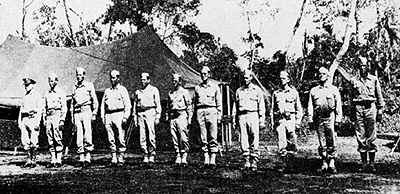 From 5 through 9 August, 112th Cavalry patrols plunged into the jungles,
searching for the Japanese and hoping to cut off the disorganized enemy's retreat. The Japanese, however, withdrew southeasterly, not in the easterly direction General Hall had anticipated.
From 5 through 9 August, 112th Cavalry patrols plunged into the jungles,
searching for the Japanese and hoping to cut off the disorganized enemy's retreat. The Japanese, however, withdrew southeasterly, not in the easterly direction General Hall had anticipated.
Regimental HQ and squadron commanders, 112th Cavalry, Aitape, 11 August 1944.
Thus Ted Force, moving South, encountered some resistance from the 237th Infantry, but most of the Japanese they killed were service support personnel, not infantrymen. Indicative of the caliber of opposition, Ted Force managed to suffer more casualties from friendly artillery fire than from enemy action.
Even the hunt for Japanese stragglers was not always one-sided. Enemy snipers shot and wounded the point man of a patrol on 8 August. He had the unfortunate distinction to be the last 112th Cavalry battle casualty as the campaign was visibly winding down and had degenerated into a chase, albeit a dangerous one, after Japanese stragglers. Cavalrymen shot several stragglers daily and occasionally discovered mass Japanese graves or piles of rotting corpses. On 10 August the 112th received orders to return to Aitape, and the next day they marched north to the mouth of the Driniumor.
Before the cavalrymen reached the beach, where they would board trucks to ride to Aitape, Lieutenant Colonel Grant ordered his 1st Squadron to stop at a stream in order to wash and shave. Then they continued towards the beach. As they emerged from the jungle, the 112th Band began to play and the men fell into march order. After forty-five days on the line, many troopers had jungle ulcers on their hands and feet. Some had blood oozing from their boots. But they marched to their waiting trucks. They had come to the Driniumor in trucks, and they left in trucks. In between, they suffered 317 battle casualties or 21 percent of their authorized strength, probably 26 or 27 percent of their actual pre-Driniumor strength. They claimed to have killed more than 1,600 Japanese, the majority of these during the bloody Japanese attacks of early August and the subsequent straggler hunt. Overall American losses were 440 killed, 2,550 wounded, and 10 missing.
[98]
General Adachi's survivors meanwhile made their painful way back towards
Wewak. His 20th and 41st divisions had lost more than 8,000 men, including almost all the battalion commanders and company-grade officers. The 41st Division lost 2,519 killed, 237 missing, and 1,740 dead from illness or untreated wounds. The 20th Division's losses are shown below:
The Japanese lost close to 10,000 men overall. They claimed to have inflicted an estimated 2,000 American casualties, but nearly 3,000 Americans had been killed, wounded, or reported missing. Nor did that end 18th Army's grim saga. Even though General Krueger for "historical purposes" had declared the campaign finished on 25 August 1944, 18th Army fought on against Australian forces until V-J Day in September 1945. During those thirteen months, the Japanese lost another 7,200 killed and 270
prisoners. Australian losses were 451 killed and more than 1,160 wounded.
General Adachi formally surrendered 18th Army on 13 September 1945 and
shortly afterwards committed suicide at Rabaul, where the Australians had taken him to stand trial for war crimes.
The men of the 112th Cavalry joined the 1st Cavalry Division in the Leyte campaign in November 1944 and later landed at Lingayen Gulf in January 1945. On V-J Day the regiment sailed into Tokyo Bay and the next day began its occupation duty in Japan.
Chapter 7: Attrition
Regiment Pre-Battle
StrengthPost-Battle
StrengthLosses Pre-Battle
Percentage Lost
78th Infantry 1,300 350 950 73
79th Infantry 700 350 350 50
80th Infantry 1,010 320 690 69
26th Field Artillery 990 450 540 56
Other 2,612 1,570 1,042 40 Total 6,612 3,040 3,572 55
Chapter 7: Directives
Chapter 7: Miyake Force
Chapter 7: Regrouping
Chapter 7: Rescue of Troop C
Chapter 7: US Redeployment
Chapter 7: Japanese Flank Attack
Chapter 7: Japanese Change of Plan
Chapter 7: Aftermath
Back to Table of Contents -- Leavenworth Papers # 9
Back to Leavenworth Papers List of Issues
Back to MagWeb Master Magazine List
© Copyright 2005 by Coalition Web, Inc.
This article appears in MagWeb.com (Magazine Web) on the Internet World Wide Web. Other articles from military history and related magazines are available at http://www.magweb.com